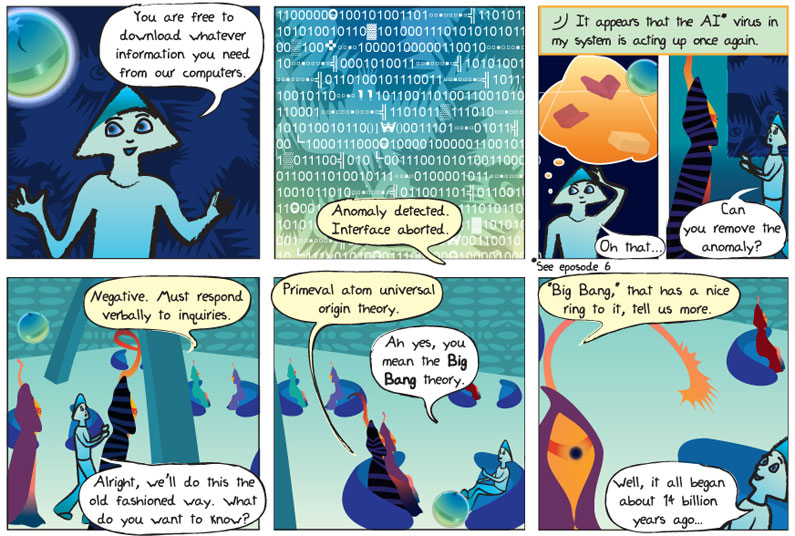
Transcript:
Panel 1
Alkina: You are free to download whatever information you need from our computers.
Panel 2
Worldship: Anomaly detected. Interface aborted.
Panel 3
Epo: It appears that the A1 virus in my system is acting up again.
Alkina: Oh, that… Can you remove the anomaly?
Panel 4
Worldship: Negative. Must respond verbally to inquiries.
Alkina: Alright, we’ll do this the old fashioned way. What do you want to know?
Panel 5
Worldship: Primeval atom universal origin theory.
Alkina: Ah, yes, you mean the Big Bang theory.
Panel 6
Worldship: “Big Bang”, that has a nice ring to it, tell us more.
Alkina: Well, it all began about fourteen billion years ago.
What does it mean?
Big Bang – This famous theory suggests that the Universe was not always as it is today, and that at one point everything was compressed down into an extremely small point of unimaginable heat and density. Then, in the most violent and energetic event ever to occur, the Universe began to expand and evolve into its present state. This rapid expansion was aptly named the “big bang.”
In human speak please!
The idea of the Big Bang theory is actually quite recent as far as big ideas in cosmology go. Before it was proposed, most astronomers believed in a “steady state” Universe that did not change and has always existed in its current state. The Big Bang theory was first introduced in a paper by physicist Georges Lemaitre in 1927, however, he referred to it as the “primeval atom” theory.
The evidence that supported a finite beginning of the Universe was provided by astronomer Edwin Hubble, who observed that distant galaxies were moving away from each other. This means that some time in the past, all matter in the Universe must have existed in a small volume.
Another reason to rule out a steady state Universe is the fact that gravity would cause all matter in the Universe to collapse to a common center. Albert Einstein understood this prediction when he published his theory of gravity, General Relativity, in 1916. To fix the theory, Einstein added a repulsive term to his equations that counteracted gravity’s attraction. He called this term the cosmological constant. A decade later when Hubble published his discovery that the Universe is expanding, Einstein realized his mistake: instead of adding an antigravity term to his theory, he could have predicted that the Universe expanded. That would have also given a stable solution to his equations. Einstein called this his life’s “biggest blunder.”
The cosmological constant was virtually abandoned for many decades after Hubble’s announcement. Then, in 1998, two teams of astronomers working independently made the same discovery: not only is the Universe expanding, the rate of expansion is actually speeding up. This requires some sort of antigravity effect in the Universe. Maybe the cosmological constant is with us after all.
Ironically, the name “Big Bang” was given to the theory by Fred Hoyle, a major supporter of the steady state theory, in an attempt to discredit the new theory.
Is that all?
The Big Bang – The story of our Universe in five paragraphs.
